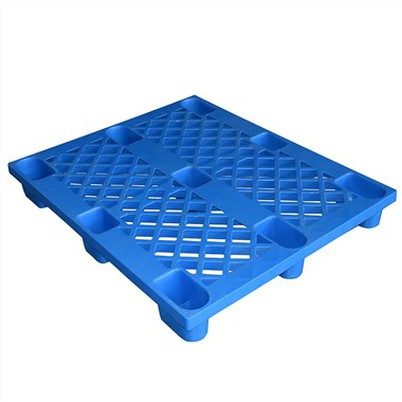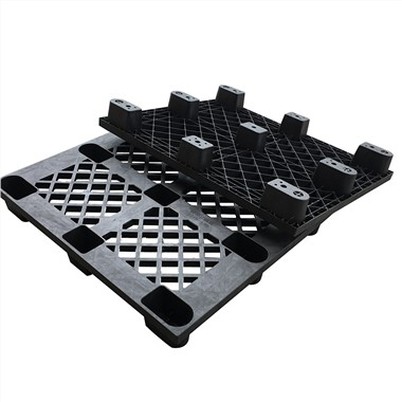Can 48 X 48 plastic pallets be used in freezer environments?
Leave a message
Can 48 X 48 Plastic Pallets be Used in Freezer Environments?
As a supplier of 48 X 48 plastic pallets, I often get asked whether our pallets can be used in freezer environments. It's a crucial question, especially for industries dealing with frozen goods, such as food and pharmaceutical sectors. In this blog, I'll explore the viability of using 48 X 48 plastic pallets in freezers, considering various factors like material properties, design features, and practical applications.
Material Considerations
The material of a plastic pallet plays a significant role in its performance in freezer environments. Most of our 48 X 48 plastic pallets are made from high - density polyethylene (HDPE) or polypropylene (PP). These materials have distinct properties that make them suitable for cold storage.
HDPE is known for its excellent impact resistance, even at low temperatures. It has a relatively low glass transition temperature, which means it remains flexible and tough in cold conditions. This property is essential in a freezer environment where pallets are likely to be exposed to shock and vibration during handling and transportation. For example, when forklifts are moving pallets in and out of freezers, the pallets need to withstand the impact without cracking or breaking.
Polypropylene also has good chemical resistance and can maintain its structural integrity in cold temperatures. It is lightweight, which can be an advantage in reducing transportation costs. However, compared to HDPE, PP may become slightly more brittle at extremely low temperatures, but with proper design and manufacturing techniques, this can be mitigated.
Our Full Perimeter Hdpe Plastic Pallet is a great example of a pallet made from HDPE that is well - suited for freezer use. The full - perimeter design provides additional strength and stability, and the HDPE material ensures it can handle the cold environment.
Design Features
The design of a 48 X 48 plastic pallet is another important factor in its suitability for freezer environments. A well - designed pallet should have features that enhance its performance in cold conditions.
One of the key design features is the rib structure. Pallets with a well - engineered rib structure distribute weight evenly, which is crucial when pallets are loaded with heavy frozen goods. The ribs also add to the overall strength of the pallet, making it more resistant to deformation. For instance, our Medium Duty Plastic Full Perimeter Pallet has a carefully designed rib pattern that not only provides strength but also allows for proper air circulation, which can be beneficial in maintaining the temperature of the goods on the pallet.
Another important design aspect is the fork entry. In a freezer environment, forklift operators need to be able to easily and quickly insert the forks into the pallets. Our pallets are designed with wide and clear fork entries to ensure smooth handling. This reduces the risk of damage to the pallets during loading and unloading operations.
Injection - molded pallets, such as our Injection Molded Plastic Pallet, offer precise dimensions and a consistent quality. The injection - molding process allows for complex designs that can be optimized for freezer use. These pallets have a smooth surface, which is easy to clean and sanitize, an important requirement in food and pharmaceutical industries where hygiene is of utmost importance.
Practical Applications
In real - world freezer applications, 48 X 48 plastic pallets have proven to be a reliable choice. They are widely used in cold storage warehouses, food processing plants, and pharmaceutical distribution centers.
In cold storage warehouses, pallets are used to store and stack frozen goods. The ability of plastic pallets to withstand low temperatures and heavy loads makes them ideal for this purpose. They can be stacked multiple layers high without losing their shape or structural integrity. This efficient use of space is crucial in a warehouse environment where storage capacity is often limited.
Food processing plants also benefit from using 48 X 48 plastic pallets in freezers. These pallets are easy to clean and can be sanitized to meet strict food safety standards. They are also resistant to chemicals and moisture, which are common in food processing environments. For example, in a meat processing plant, pallets need to be able to withstand exposure to blood, water, and cleaning agents, all while remaining in good condition in the freezer.
Pharmaceutical distribution centers require pallets that can maintain the integrity of temperature - sensitive drugs. Our plastic pallets, with their ability to perform well in cold conditions, help ensure that the drugs are stored and transported at the appropriate temperature, thus maintaining their efficacy.
Advantages over Other Pallet Types
Compared to wooden pallets, 48 X 48 plastic pallets have several advantages in freezer environments. Wooden pallets are prone to moisture absorption, which can lead to rot and decay in a cold and humid freezer. They also splinter easily, which can pose a risk to the goods and the handling equipment. In contrast, plastic pallets are waterproof and do not splinter, providing a safer and more durable option.
Metal pallets, on the other hand, can be heavy and expensive. They may also rust in a cold and moist environment, which can contaminate the goods. Plastic pallets are lightweight, corrosion - resistant, and cost - effective, making them a more practical choice for freezer use.
Challenges and Mitigations
While 48 X 48 plastic pallets are generally suitable for freezer environments, there are some challenges that need to be addressed. One of the main challenges is the potential for static electricity buildup in cold and dry conditions. Static electricity can be a problem in industries where flammable substances are present. To mitigate this issue, we can offer anti - static plastic pallets. These pallets are treated with special additives that reduce the buildup of static electricity, ensuring a safe working environment.


Another challenge is the potential for brittleness at extremely low temperatures. However, by using high - quality materials like HDPE and optimizing the design, we can minimize this risk. Our R & D team is constantly working on improving the performance of our pallets in cold conditions, conducting tests at different temperatures to ensure they meet the highest standards.
Conclusion
In conclusion, 48 X 48 plastic pallets can indeed be used in freezer environments. The combination of suitable materials like HDPE and PP, well - designed features such as rib structures and fork entries, and their practical applications in various industries make them a reliable choice. They offer several advantages over wooden and metal pallets, including durability, hygiene, and cost - effectiveness.
If you are in need of 48 X 48 plastic pallets for your freezer operations, we are here to help. Our team of experts can provide you with detailed information about our products and assist you in choosing the right pallet for your specific needs. Contact us today to start a discussion about your procurement requirements. We look forward to working with you to find the best solution for your freezer pallet needs.
References
- ASTM International. (20XX). Standard Specifications for Plastic Pallets.
- European Pallet Association. (20XX). Guidelines for Pallet Use in Cold Storage.
- Industry reports on plastic pallet manufacturing and usage in cold environments.






